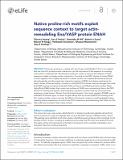Native proline-rich motifs exploit sequence context to target actin-remodeling Ena/VASP protein ENAH
Author(s)
Hwang, Theresa; Parker, Sara S; Hill, Samantha M; Grant, Robert A; Ilunga, Meucci W; Sivaraman, Venkatesh; Mouneimne, Ghassan; Keating, Amy E; ... Show more Show less
DownloadPublished version (3.556Mb)
Publisher with Creative Commons License
Publisher with Creative Commons License
Creative Commons Attribution
Terms of use
Metadata
Show full item recordAbstract
<jats:p>The human proteome is replete with short linear motifs (SLiMs) of four to six residues that are critical for protein-protein interactions, yet the importance of the sequence surrounding such motifs is underexplored. We devised a proteomic screen to examine the influence of SLiM sequence context on protein-protein interactions. Focusing on the EVH1 domain of human ENAH, an actin regulator that is highly expressed in invasive cancers, we screened 36-residue proteome-derived peptides and discovered new interaction partners of ENAH and diverse mechanisms by which context influences binding. A pocket on the ENAH EVH1 domain that has diverged from other Ena/VASP paralogs recognizes extended SLiMs and favors motif-flanking proline residues. Many high-affinity ENAH binders that contain two proline-rich SLiMs use a noncanonical site on the EVH1 domain for binding and display a thermodynamic signature consistent with the two-motif chain engaging a single domain. We also found that photoreceptor cilium actin regulator (PCARE) uses an extended 23-residue region to obtain a higher affinity than any known ENAH EVH1-binding motif. Our screen provides a way to uncover the effects of proteomic context on motif-mediated binding, revealing diverse mechanisms of control over EVH1 interactions and establishing that SLiMs can’t be fully understood outside of their native context.</jats:p>
Date issued
2022Department
Massachusetts Institute of Technology. Department of BiologyJournal
eLife
Publisher
eLife Sciences Publications, Ltd
Citation
Hwang, Theresa, Parker, Sara S, Hill, Samantha M, Grant, Robert A, Ilunga, Meucci W et al. 2022. "Native proline-rich motifs exploit sequence context to target actin-remodeling Ena/VASP protein ENAH." eLife, 11.
Version: Final published version